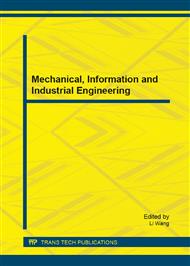p.722
p.727
p.731
p.736
p.739
p.744
p.749
p.753
p.765
Method of Suppressing Noise AM Jamming with EMD for Combined Modulation Radio Ranging System
Abstract:
In this paper, aimed at suppressing the noise amplitude modulation jamming for a novel combined modulation radio ranging system, which transmits the waves combining pseudo random binary phase code (PRBPC) with linear frequency modulation (LFM), a signal processing method based on the empirical mode decomposition (EMD) and reconstruction of the target correlation peak signal is presented. Firstly, the correlation detection output signal of the ranging system is theoretically derived and proved to meet the condition of the Intrinsic Mode Function (IMF). Then the EMD processing for the target correlation peak signal, completely covered by the noise amplitude modulation (AM) jamming, is done and decomposes the signal into several IMFs. The difference of certain main IMF between the target signal and the strong jamming is utilized to reconstruct the target correlation function as the input signal of the detecting part. It is proved by simulation that the processing gain to the noise AM jamming can be significantly improved and the main lobe of the reconstructed correlation peak signal is more obvious, therefore it can be more easily identified.
Info:
Periodical:
Pages:
739-743
Citation:
Online since:
March 2015
Authors:
Keywords:
Price:
Сopyright:
© 2015 Trans Tech Publications Ltd. All Rights Reserved
Share:
Citation:


